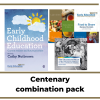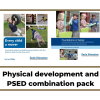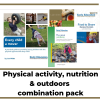Charting a pedagogical course through stormy seas
by Victoria Jefferies Sea state: rough, occasionally very rough, rarely smooth! It’s rarely plain sailing in Early Childhood Education and Care (ECEC) with its myriad
This article by Early Education Associate Anni McTavish explores the term “cultural capital”, and what it might mean for early years practitioners and their settings.
Following the publication of the new Education Inspection Framework (EIF) in May 2019, the updated Ofsted School and Early Years (EY) Inspection Handbooks came into effect from September 2019. These contain essential information for all Ofsted-registered settings, including nurseries, pre-schools, playgroups, and childminders.
One of the key aims of the new EIF is to focus more on how settings are using their curriculums to enhance experiences and learning through the EYFS, as well as continuing to reduce the amount of unnecessary paperwork: “We will want to see if young children – particularly the disadvantaged – are thinking and talking about a wide range of experiences that prepare them for what comes next.” (Gill Jones, Ofsted Early Education Deputy Director, speaking in Nursery World Magazine, May 2019)
This revised approach to curriculum (what educators are teaching), is reflected in the new Ofsted judgement: “Quality of Education”. Also included in this judgement is the term cultural capital, which is defined as: “the essential knowledge that children need to be educated citizens” (Ofsted EY Inspection Handbook 2019, p31). It goes on to say:
Understandably, this new term has provoked plenty of discussion and questions about what it will actually mean for practice. How is ‘cultural capital’ different from the sort of enriching experiences provided by skilled practitioners, who know their children well, and have high aspirations for their learning and development?
There are some concerns that the term cultural capital, without a clear meaning or intention, may encourage negative attitudes or assumptions linked to class and ethnicity (Cowley, 2019; Mickelburgh, 2019; Moylett, 2019). ‘Essential knowledge’ seems to imply experiences such as: visits to the theatre, art galleries, museums or listening to classical music, which are traditionally middle-class, and may be judged as having a higher value than others.
What is Cultural Capital?
The term cultural capital is not new. It is a complex theory that comes originally from the field of sociology, which involves the study of society, including relationships, social interactions and culture. It is important to recognise that everyone has cultural capital – that is – knowledge, skills and behaviours, and that these accumulate over time through many different experiences and opportunities. Cultural capital is understood to contribute to ‘getting on in life’ or ‘social status’, i.e. being able to perform well in school, knowing how to talk in different social groups or societies, accessing higher education and being successful in work or a career.
Perhaps, most importantly, definitions of cultural capital might recognise and reflect on one of the core principles of the EYFS, the Unique Child: ‘every child is a unique child, who is constantly learning and can be resilient, capable, confident and self-assured’ (EYFS, 2017). Ofsted also want to reassure practitioners that this new term is not about having to create a ‘cultural capital display’, or about a new area of learning called ‘cultural capital’, or indeed about attending a special training course on cultural capital (Ofsted Webinar, June 2019). They are clear that: ‘It is the role of the setting to ensure that children experience the awe and wonder of the world in which they live, through the seven areas of learning.’ (143 p31 Ofsted Early Years Inspection Handbook, Sept 2019)
Rather than thinking of cultural capital as a thing that must be ‘given’ or ‘taught’, it might be more helpful to think first and foremost about the cultures, languages and traditions that children and their families bring, and how we might value and celebrate this.
Valuing the cultures of children and families
Every child and family who joins a setting will have their own knowledge and experiences that will link to their culture and wider family. This might include: languages, beliefs, traditions, cultural and family heritage, interests, travel and work. Research shows that when children and families’ cultures are valued, both the child’s experience of learning and progress can benefit (Husain et al., 2018, p. 4 and Gazzard, E. 2018 in Chalmers, H. and Crisfield, E. 2019)
Getting to know children and families and building warm, positive relationships will be crucial. When families feel comfortable and settled, they are far more likely to share who they are and what is important to them. Inviting parents to talk about their dreams and aspirations for their children will be part of this.
Observing, and joining-in with play, and talking and chatting together, will support practitioners to understand children’s interests; what they can do and any difficulties they might have. Furthermore, listening to families and finding out what their children enjoy and like to do (or don’t), and any worries they might have, will help with planning relevant and stimulating play and learning experiences.
Other theoretical models also emphasise the importance of valuing children’s cultures. With its roots in Vygotsky’s social learning theory, ‘funds of knowledge’ (McDonald, 2018) is about recognising that a child does not arrive ‘empty’, but already knows many things when they start school. The role of the EY setting is to allow children to explore and build on these funds of knowledge. In a similar way, Thomson (2001) theorised about the idea of a ‘virtual schoolbag’ to describe how children start school with an invisible bag that is “full of things they may have already learnt at home, with their friends, and in and from the world in which they live”. The important question is whether children are invited to open this ‘virtual backpack’, and, if so, how their knowledge and experiences are respected and built on creatively within the school setting?
Some other practical ideas to help you to support and value children’s cultures
Providing a rich and varied curriculum that builds on children’s experiences and cultures
Children will benefit most from a flexible curriculum that builds on what they understand and know already. This will also include thinking about and planning for any particular special educational needs or disabilities. Being aware of what children might need, how you will provide this, and then assessing the impact will be essential. For example:
“I knew that one of my key children had arrived with limited experience of outdoor play, so I thought it was very important to spend time with them in the garden, and encourage them to explore the area fully. I also made sure that they were able to participate in outdoor-focussed learning as much as possible. One afternoon we made kites, and this provoked lots of new vocabulary, as well as some wonderful interactions between the children. I could see that these experiences were having a very positive effect, and that A’s confidence, language and physical skills were thriving.”
As well as responding to children’s interests, new and inspiring experiences will be of great benefit – remember the phrase ‘awe and wonder’. It is clear that Ofsted will be looking at what settings do to build on children’s learning and understanding, through both adult-guided and child-initiated play:
‘Early years settings will also be evaluated on ‘cultural capital’, that is ‘how well leaders ensure that the curriculum they use or create enhances the experiences and opportunities available to children, particularly the most disadvantaged’ (Nursery World, January 2019)
Points that are worth considering:
Gradually widening children’s experiences as the year progresses will be an important step in providing rich and engaging learning across the curriculum. Headteacher Julian Grenier explains his setting’s policy:
“In my current role, we plan carefully for children to have progressively richer experiences beyond the nursery school gate. We start with simple trips to the local park, shops and on buses – unfamiliar experiences for some children. As the year progresses, we visit different places of worship, the Olympic Park and the great museums in central London. Finally, there is our summer trip to the seaside. This had particular meaning for Ruby, a four-year-old who spent considerable periods of her time in nursery playing with baskets of shiny stones and shells, arranging them differently to create designs and pictures. She was first overwhelmed and then absolutely fascinated by all the stones she saw on the Essex shore. She spent almost a whole day holding them, stacking them up, throwing them into the sea and talking about them.”
(May 2019, Impact Magazine: What Happened to Curriculum in Early Years)
It will be up to settings to decide for themselves, within the EYFS framework, what their curriculum should include to best fulfil children’s needs and learning. How this is done, and how this is measured will again be up to individual settings. It may mean utilising additional funding, i.e. through the early years pupil premium to support particular groups.
Skilled and knowledgeable practitioners will be able to plan enticing opportunities to support and extend learning for all children. For example, providing a good range of quality story books (see further info) will support many different areas of learning, including language and literacy. Reading together in small groups, drawing children’s attention to pictures and words, asking and inviting questions etc will expand on children’s thinking, their social skills and knowledge of books, vocabulary and ‘book language’. Learning might be deepened further by incorporating props, and exploring the story through role-play, drama or small-world. Songs, rhymes or music that link to the text might enhance learning still more, and an outing could be planned to hear the story at the local library, or to see it acted out at a community theatre.
A curriculum that is ambitious and aspirational for all will enhance the cultural capital of every child and family.
(all articles, journals and films accessed Sept 2019):
Chalmers, H and Crisfield, E (2019) Drawing on linguistic and cultural capital to create positive learning cultures for EAL learners
Education Inspection Framework 2019
Ofsted Schools Inspection Handbook Sept 2019
Ofsted Early Years Inspection Handbook Sept 2019
Ofsted Education Inspection Framework Webinar (June 2019)
Gaunt, C. (Jan 2019) Education inspection framework 2019: key changes for early years, Nursery World Magazine
Cowley, S. (May 2019) Defining ‘cultural capital’ in terms of best practice
Grenier, J., (May 2019) What Happened to Curriculum in Early Years? Impact, Journal of the Chartered College of Teaching
McDonald, A. (Feb 2018) How to use Funds of Knowledge in your Classroom and Create Better Connections
Mickelburgh, J. (May 2019) The Theories behind Cultural Capital
Moylett, H. (March 2019) Ofsted’s thinking on Cultural Capital
Thomson, P. (2001) Schooling the Rustbelt Kids: Making the Difference in Changing Times
What happens on an early years inspection? A short YouTube video with Wendy Ratcliff, Her Majesty’s Inspector, Senior Manager, Early Years, who explains why you should not do something different in your setting, just because you think Ofsted might want to see it
With thanks to Jo Metivier for professional feedback and critique.
by Victoria Jefferies Sea state: rough, occasionally very rough, rarely smooth! It’s rarely plain sailing in Early Childhood Education and Care (ECEC) with its myriad
The letter below sets out our key asks for the next government.
Early Education Associate, Debi Keyte-Hartland reflects on a recent commission by Balcarras Teaching School Hub In Gloucestershire to deliver a four-day course on Sustained Shared
by Frances Giampapa and Claire Lee Introduction A wealth of evidence demonstrates the fundamental role played by early years (EY) education in shaping a thriving
UK early years curricula England The Early Years Foundation Stage statutory framework applies in England for early years provision for children from birth to 5.
by Katherine Gulliver Introduction Early Education was recently asked to review the special educational needs and/or disabilities (SEND) provision in the early years within one
Clare Devlin, Early Education Associate What aspects of physical development should we focus on within the Early Years Foundation Stage (EYFS) and other early years
By Debi Keyte-Hartland, Early Education Associate This article is based on one included in the Early Education Journal no 100. To access the full article
In this article, Kate Irvine from Bristol Early Years discusses the impact of practitioners engaging in a sustained process of CPD through cluster groups and
by Dr Jo Albin-Clark, Edge Hill University and Dr Nathan Archer, Leeds Beckett University Inspection in the news Being involved in education in England involves
What are “Fundamental British Values”? by Vicky Hutchin The so-called “Fundamental British Values” form a part of the Prevent Duty, introduced in 2015 and last
The open letter below was sent to Ofsted in November 2023. Download Ofsted’s response We the undersigned are writing to you about the recently published
by Clarissa Frigerio Why are there so few men teaching in the early years? I have worked in the profession for almost 9 years, and
Early childhood education today has been influenced by key figures such as Froebel, Montessori, Isaacs and MacMillan. Much recent research has supported their ideas although
We deplore the recent article by The Telegraph which singled out Liz Pemberton for criticism of her anti-racism training, which she has delivered for many
Sustained shared thinking: An episode in which two or more individuals “work together” in an intellectual way to solve a problem, clarify a concept, evaluate
Early years pedagogy is the theory that informs the practice of teaching children in the early years. The pedagogical research has been carried out by
by Cathy Gunning What is reflective practice? Reading a book by Donald Schon early on in my career as a teacher opened my eyes to
The Early Career Framework has been designed by the Department for Education in England to support newly qualified teachers in England with a structured package of support
The following extracts from past early years teaching newsletters have a feature which supports your team dialogue around pedagogy and practice dilemmas and reflective practice.
Last updated Spring 2018. The preschools of the Reggio Emilia in Northern Italy inspire us with their pedagogy and practice in giving children rich encounters
In most cases, sound early years principles and practices are already in place in settings. The EYPP funding allows settings to review and refine what
Who was Friedrich Froebel (1782-1852) Born on 21 April 1782 Friedrich Froebel was a German educator who invented the kindergarten. He believed that “play is
The Exploring the Wider World Project was funded by the Stoke-on-Trent Opportunity Area and was delivered by Early Education between April 2019 and March 2020.
The direction of the project has been dictated by three key factors: a deep understanding of how young children learn best, developing sustainability for practice,
Rethinking our consideration of what an outing or a visit may be has been central to the project. Children need to build up their knowledge
Using the local environment enables children to develop a sense of belonging to the local community. It helps them to develop a sense of place
An early task for the Exploring the Wider World project was to identify the barriers to taking children out and about beyond the setting. Only
Risk is a natural part of our existence, as we look to explore and make sense of the world around us. What is key is
This page brings together all the key project elements of thinking through a trip or a visit in one handy place, with downloadable resources for
Meaningful learning opportunities relating to understanding the world rely on rich and stimulating resources. Consider what you have Rich and well thought out resources make
A reflection based upon rich and varied experiences of taking young children out into the Wider World by Kathryn Solly, Early Education Associate. Beginnings There
It is important to remember that the world of a 2-year-old is very different to ours. They are hugely fascinated by the things that we
By the time children get to be 3 years of age, they are, generally, better at walking and so can walk for longer periods of
Most 4-year-olds can walk faster and further than their younger counterparts. This means that they can venture further afield than the three year olds in
Walking is a great way to stay active for people for all ages. Particularly for children, walking: is fun and interesting – you get to
Using public transport can be really exciting for young children, especially for those who spend lots of time in cars, being ferried from place to
Social media is a powerful tool for sharing examples of good practice and celebrating achievements – but there potential pitfalls, particularly relating to consent. We
Since the introduction of the EYFS framework in 2008 there has been a huge emphasis upon encouraging parents to become engaged in their children’s learning.
Transition is part of the maturation process. Most children and their families find moving from one stage to the next seamless. Transitions need careful planning and will
We know young children appear to be starting settings with less developed language than in previous years due to a range of reasons. Understanding the
Welcome to the e-book Child-Centred Competences for Early Childhood Education and Care. The book brings together four years of research undertaken by early childhood academics
Introduction Race and racism in society is as important as ever; I am writing not only as a British South Asian who has experienced racism,
Raymond Williams maintained, after years of examining constructs of culture and society that “Culture is one of the two or three most complicated words in









Early Education
2 Victoria Square
St Albans
AL1 3TF
T: 01727 884925
E: office@early-education.org.uk